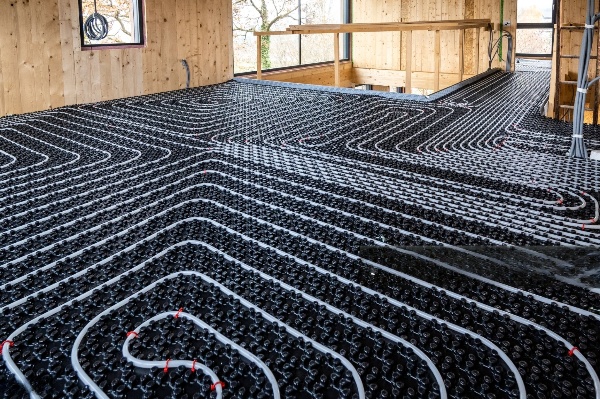Basement Floor Heating: A Comfort Upgrade You’ll Love

Strong 8k brings an ultra-HD IPTV experience to your living room and your pocket.
Basements often have a reputation for being cold, dark, and unwelcoming. However, with advancements in home heating technology, it’s easier than ever to transform these spaces into warm, inviting areas. One of the most popular solutions is basement floor heating. Offering both comfort and efficiency, this modern upgrade is perfect for homeowners who want to maximize the usability of their basement while adding a touch of luxury.
This article delves into the benefits, types, installation process, and maintenance of basement floor heating systems, helping you decide if it’s the right choice for your home.
The Appeal of Basement Floor Heating
Basement floor heating has become increasingly popular for a variety of reasons. Here’s why homeowners love this innovative solution:
1. Superior Comfort
Unlike traditional heating systems that warm the air, floor heating directly warms the floor. This creates an even distribution of heat, ensuring that every corner of your basement feels cozy and inviting.
2. Energy Efficiency
Floor heating systems are highly energy-efficient, as they require lower operating temperatures compared to forced-air systems. This can lead to significant savings on energy bills over time.
3. Space-Saving Design
Since basement floor heating systems are installed beneath the flooring, they don’t take up valuable space or interfere with your interior design. This makes them an excellent choice for smaller basements.
4. Enhanced Aesthetics
Without the need for bulky radiators or vents, your basement retains a clean and uncluttered look, allowing you to focus on décor and functionality.
5. Improved Indoor Air Quality
Traditional heating systems can circulate dust and allergens, but floor heating systems eliminate this problem, offering a cleaner and healthier environment.
Types of Basement Floor Heating Systems
There are two main types of floor heating systems: electric radiant heating and hydronic heating. Each has its advantages, and the choice depends on your specific needs and budget.
1. Electric Radiant Heating
How It Works: Electric cables or mats are installed beneath the flooring. These cables generate heat when electricity passes through them.
Ideal For: Smaller spaces or areas that don’t require continuous heating.
Advantages:
Easy and quick to install.
Lower upfront cost compared to hydronic systems.
Suitable for retrofitting existing basements.
2. Hydronic Heating
How It Works: A network of pipes circulates heated water beneath the floor, generating consistent and efficient warmth.
Ideal For: Larger basements or homes that require a whole-house heating solution.
Advantages:
More energy-efficient over the long term.
Provides consistent, even heating.
Compatible with various energy sources, including solar or geothermal systems.
Key Considerations Before Installation
Installing basement floor heating is a significant investment. Here are a few factors to consider before embarking on this project:
1. Flooring Material
Certain flooring materials work better with floor heating systems. Tile, stone, and concrete are excellent conductors of heat, making them ideal for this setup. Carpeted or hardwood floors may require additional considerations to ensure efficient heat transfer.
2. Insulation
Proper insulation is crucial to prevent heat loss and maximize the efficiency of your floor heating system. High-quality insulation helps retain warmth, reducing energy consumption.
3. Installation Costs
The cost of installing basement floor heating varies depending on the type of system, the size of your basement, and the complexity of the installation. While electric systems are generally less expensive upfront, hydronic systems may offer greater long-term savings.
4. Compatibility with Existing Heating Systems
If your home already has a heating system, ensure that the floor heating setup integrates seamlessly without disrupting overall functionality.
Installation Process
The installation process for basement floor heating typically involves the following steps:
1. Planning and Design
Assess the layout and dimensions of your basement.
Choose the type of heating system based on your needs and budget.
Determine the best placement for the heating elements to ensure even heat distribution.
2. Preparing the Basement Floor
Remove existing flooring to access the subfloor.
Ensure the subfloor is clean, level, and well-insulated to prevent heat loss.
3. Installing Heating Elements
For electric systems, install heating cables or mats according to the manufacturer’s guidelines.
For hydronic systems, lay down the network of pipes and connect them to a boiler or water heater.
4. Connecting the System
Electric systems are connected to a thermostat and power supply.
Hydronic systems are connected to the boiler and circulation pump.
5. Testing and Finishing
Test the system to ensure it operates correctly.
Install the final flooring material over the heating system.
Maintenance Tips for Basement Floor Heating
Floor heating systems are designed for durability and low maintenance. However, occasional upkeep ensures optimal performance and longevity:
1. Regular Inspections
Check for any visible damage or wear on the flooring.
For hydronic systems, inspect the boiler and pipes periodically.
2. Clean the Floor
Keep the floor clean and free of debris to prevent damage to the heating elements.
3. Monitor Energy Usage
Track energy consumption to detect any irregularities that may indicate system inefficiencies.
4. Schedule Professional Servicing
Hire a professional to perform routine maintenance, particularly for hydronic systems, which involve more complex components.
Benefits of Basement Floor Heating for Your Home
Basement floor heating offers a range of benefits beyond comfort and efficiency:
1. Increased Property Value
Homes with floor heating systems are highly desirable in the real estate market. This feature can set your property apart from others.
2. Year-Round Usability
A warm and cozy basement becomes a functional living space throughout the year, whether as a family room, home office, or guest suite.
3. Environmental Sustainability
Hydronic systems powered by renewable energy sources like solar panels or geothermal systems reduce your carbon footprint, contributing to a more sustainable home.
4. Personalized Comfort
With programmable thermostats, you can customize the temperature to suit your preferences, ensuring maximum comfort at all times.
Why Choose Basement Floor Heating?
If you’re looking for a way to transform your basement into a warm, inviting space, basement floor heating is a worthwhile investment. It’s perfect for families who value comfort, energy efficiency, and modern design. Whether you’re renovating your basement or building a new home, this upgrade offers a practical solution that adds both functionality and luxury.
Conclusion
Basement floor heating is more than just a comfort upgrade—it’s an investment in your home’s value, aesthetics, and energy efficiency. By choosing the right system and working with experienced professionals, you can enjoy a warm and welcoming basement space for years to come.
Whether you opt for electric radiant heating or a hydronic system, this modern solution ensures your basement becomes a beloved part of your home. Embrace the luxury of a warm floor beneath your feet and experience the transformative power of basement floor heating.
Note: IndiBlogHub features both user-submitted and editorial content. We do not verify third-party contributions. Read our Disclaimer and Privacy Policyfor details.


